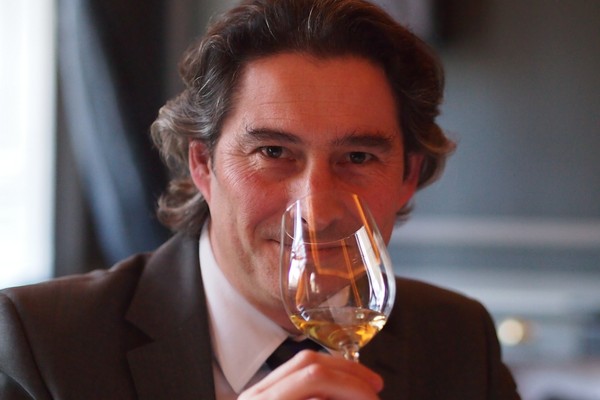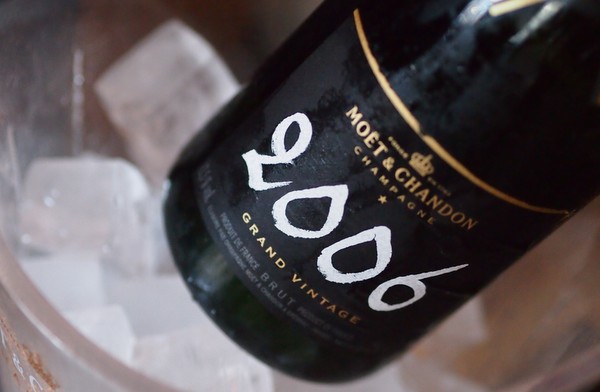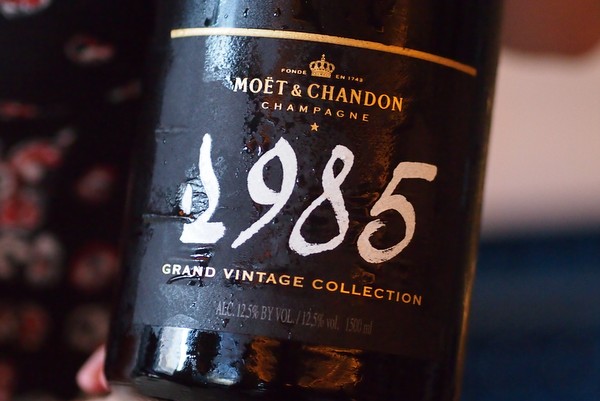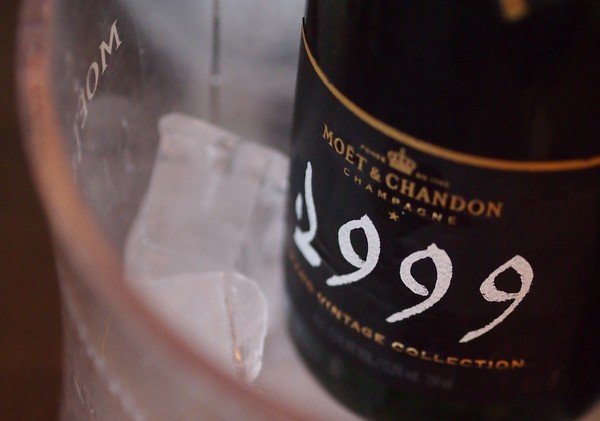The wines of Moët et Chandon, with
Benoît Gouez
Geeky Champagne talk with the chef de cave of one
of the regions most important producers

Champagne is a technical
wine. A wine geek’s playground. So it was great to be able to taste
a range of wines from Moët et Chandon, arguably Champagne’s most
famous producer, with chef de cave Benoît Gouez. Rather than give a
sales pitch and talk about the romance of Champagne, he was happy to
talk technical. For many, this sort of information is arcane, but I
just love it.
These days Moët Brut
Imperial is kept an extra three months between disgorgement and
shipment, with no bottles in the hands of consumers until 6 months
after disgorgement. A classic dosage of just below 9 g/litre is
used. When Benoît arrived in 1998 the dosage was 13 g/litre as a
rule.'We trialled it and found we preferred 11 g,' he says,'But we
kept 13 g for customers.'

For the Moët vintage,
dosage was reduced from 11 g in 1998, to 9 g in 2000, to 5 g in
2002. It has been kept at that level since then. Benoît has tried
2/3 g dosage, but the wines age too fast. 'Sugar is a preservative,'
he says, 'even a little bit of it.'
'I don't think low dosage
makes a Champagne better,' he says. 'It is a question of harmony.
But we have had several vintages with good maturity, and we have
more and more reserve wines.'

'Dosage is not just
sweetening wine,' says Benoît. 'It is adding wine plus SO2 plus
sugar.' Disgorgement is an oxidative trauma: suddenly the wine gets
a bit of oxygen. 'Without SO2 and sugar, the wine declines very
fast. Low dosage wines decline very fast. Dosage is more complicated
than a sugar component. People in Champagne haven't been keen to
discuss dosage but it is a crucial factor. The more mature the
Champagne, the more unusual the disgorgement.'
Yields are often a talking
point when it comes to Champagne. If the maximum yield allowed in
Champagne is 10 tons/hectare in a particular vintage, a grower can
harvest 15 and keep the extra in reserve to compensate for a year
low in quality. The agronomic yield is what is picked; the economic
yield is what is picked for bottling in order to sell. It makes it
possible to build up reserves, so when a year like 2003 comes along
with lower yields, you can ask to use the reserve wine from another
year for bottling. 'Champagne is based on consistency in quality,
consistency in volume and consistency of price,’ says Benoît.
So of late, following some
good vintages, there are more reserve wines in the blend, which
helps contribute to the lower dosage. 'The quality of the reserve
wine is critical,' says Benoit. 'If the reserve wine is oxidative,
then the wines can be heavy.'
'NV is 90% of production of
Champagne, and it is the priority.' states Benoît. 'The quality of
reserve wines has become imperative.' The blend is now across three
years, and Benoît is not looking to use old reserve wines because he
wants to keep the wine fruity with no oxidative notes. The brioche
character comes from two years in the cellar.

Vintage wines are selected
as the most interesting wines from the harvest, without thinking
about house style. 'The idea is freedom to create more variation
from one harvest to another,' says Benoit. Since 2000, there has
been a decision to release the vintage at 7 years rather than 5.
This latest release, the 2006, follows straight on from 2005, which
wasn't very good in Champagne. 'It's difficult to make people
realise that there's no connection between Bordeaux, Burgundy and
Champagne vintages,' adds Benoît. In 2005 there was lots of botrytis
on the Pinot Meunier and Pinot Noir, but not the Chardonnay, so the
possibility remains that there could be very good Blanc de Blancs
from 2005, although generally it’s a year where the wines lacked
freshness and precision, and can age fast.
2006 was a year of
contrasts. A cold winter was followed by a rainy spring, and hail in
June, giving some heterogeneity in the vineyards. July was warm and
August rainy: it was up and down all season. The year was saved by
September, which was warm with cold nights, no rain, and some wind
to dry out the botrytis.
Harvest was spread out and
the result is quite harmonious, with a 10.2 average alcohol level
and acidity just below 7 g/litre. Chardonnay was the ripest and the
cleanest, but also lowest in acidity (6.5, whereas Pinot Noir was
6.8 and Meunier 7.2).
Each year a small
proportion of the vintage is bottles under cork rather than crown
cap. 'For bottles we want to keep more than 20 years we use cork,'
says Benoit. At the end of the 1960s Champagne houses began to use
crown caps with a liner made of cork. But it took people 20 years to
realise that these crown caps were allowing more oxygen
transmission, plus variation, plus cork taint. Since 1993 Moet have
been using cork for a small batch of each vintage. 'Now we are using
just microagglomerates for the vintage,' says Benoît. 'It is not
about reducing costs; it is a quality move.'
‘The longer you leave the
wine on lees the more you add complexity, and also the more you
build up the ageing potential. If you do disgorgement right then the
more ageing potential the wine has,’ he says. ‘I think it is a
microoxygenation that works like a vaccination, but this is just my
idea. I am not good at chemistry, but Champagnes kept on their lees
for a long time tend to stay in good shape for longer.’
THE WINES
Champagne Moët et
Chandon Brut Imperial NV
This is the second bottling based on 2010, with a July 2013
disgorgment. Subtle toast, nuts and pears on the nose with bright
citrus fruit on the palate. Lively and has a bit of complexity and
precision. 88/100
Champagne Moët et
Chandon Vintage 2006
Disgorged March 2013 (this will be the first time that the
disgorgement date is on all the bottles). 42% Chardonnay, 39% Pinot
Noir, 19% Pinot Meunier. Fruity and rich with peach, pear and spice
nose,together with some nice toastiness. The palate is fresh with
nice subtle toast notes and citrus and white peach fruit. Nicely
complex with lovely mouthfeel, this is a bit of a
bargain. 93/100
1999 was similar in some
ways to 2006, but the Meunier was much riper. Big harvest of 19
tons/hectare.
Champagne Moët et
Chandon Vintage 1999
38%Pinot Noir, 31& Chardonnay, 31% Pinot Meunier. Disgorged
2008, 6 g/l dosage. Full yellow colour. Sweet toast and citrus nose
leads to a powerful palate with a hint of mushroom and umami
savouriness. Rich toasty, peach and pear notes, but this is still
focused and fresh with a sweet vanilla/brioche character, as well as
crème brulee. 93/100
Champagne Moët et
Chandon Vintage 1985 (from magnum)
Higher in acidity, 8.7 g/l, plus more Pinot Noir (50%, with a
quarter each of the other varieties. Low yielding year of 7/tons/ha
because of winter frosts that killed lots of vines. Disgorged in
2002 after 17 years on the lees. Lively, fruity and appley with
herbs and spices. Tangy, citrussy and bright with brightness and
precision. Concentrated, showing notes of figs, herbs and subtle
whisky, as well as vanilla and toast richness. This has a nice
savoury edge. 94/100
See
also:
 Champagne
Charles Heidsieck Champagne
Charles Heidsieck
 Taittinger
Comtes de Champagne vertical Taittinger
Comtes de Champagne vertical
 Focus
on Grower Champagnes Focus
on Grower Champagnes
Wines
tasted 01/14
Find these wines with wine-searcher.com
Back
to top
|

